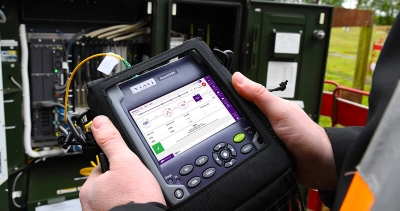How robotic vision supports immediate production monitoring
All You Required to Learn About Robotic Vision and Its Applications in Advanced Optical Dimension Equipments
Robotic vision stands for a substantial improvement in the intersection of computer vision, expert system, and machine understanding. This innovation boosts the accuracy of optical measurement systems, enabling real-time data evaluation and enhanced quality assurance. Its influence extends several fields, from producing to healthcare. The advancing landscape of robot vision increases inquiries regarding future capacities and applications. What advancements lie in advance in this transformative field?
Understanding Robotic Vision: Secret Concepts and Technologies
Robotic vision encompasses the modern technologies and methods that make it possible for equipments to analyze and comprehend aesthetic details from their setting. This field combines elements of computer vision, expert system, and artificial intelligence to promote automatic decision-making based on visual information. Trick principles include photo handling, which involves the improvement and evaluation of images to draw out significant functions, and object recognition, which enables devices to identify and identify things within a scene.

The Integration of Robotic Vision With Optical Measurement Solutions
As industries progressively require accuracy and efficiency, the combination of robot vision with optical dimension systems has arised as a transformative strategy. This harmony enables robotics to view and analyze their environments, improving the ability of optical measurement systems to assess and examine objects with unparalleled accuracy. By outfitting optical sensors with innovative imaging innovations, robot vision makes it possible for real-time data collection and handling, assisting in immediate changes to measurement criteria.
The mix equips automated systems to spot variations in measurements, surface quality, and placement, which are essential in high quality control processes. Boosted formulas, such as device knowing, more boost this integration by improving the systems' ability to adapt to various settings and scenarios. As a result, the combination not just improves measurement procedures however also decreases errors, making certain that items meet rigorous sector requirements, consequently solidifying the role of robot vision in the future of optical measurement systems.
Applications of Robotic Vision in Manufacturing
In modern-day production settings, making use of vision systems has reinvented manufacturing processes by enabling makers to do tasks with exceptional accuracy and speed. Robotic vision systems are increasingly used for quality assurance, where they inspect items for flaws and warranty adherence to specifications. These systems utilize video cameras and progressed formulas to analyze items in real-time, considerably minimizing the danger of human mistake.
Additionally, robotic vision facilitates automation in production line, enabling robotics to accurately determine components and assemble them with marginal downtime. This innovation also improves supply administration, as vision systems can check supply levels and identify inconsistencies, ensuring a seamless Get More Info supply chain.
Robotic vision help in the application of smart factories, where information from vision systems can be incorporated with various other technologies to enhance process (optical measurement system). On the whole, the applications of robotic vision in producing demonstrate its browse around this site important duty in boosting effectiveness, high quality, and productivity across numerous industries
Robotic Vision in Healthcare: Reinventing Individual Treatment

In recovery, robotic vision help in keeping an eye on person progress and tailoring treatment sessions to private demands. It supports clinical professionals by automating jobs such as data collection and person monitoring, permitting for even more time to concentrate on straight patient communication. Furthermore, robotic vision boosts telemedicine by allowing remote diagnosis and virtual assessments, linking the gap between clients and health care service providers. Generally, the application of robot vision in healthcare is transforming individual treatment, leading to improved end results, efficiency, and patient fulfillment.
Future Fads and Growths in Robotic Vision Technology
The quick advancement of robot vision innovation assures to better enhance its applications throughout different sectors, including medical care. Future patterns show a significant change in the direction of integrating fabricated intelligence and artificial intelligence, allowing systems to pick up from vast datasets and improve precision with time. Enhanced sensing unit innovations and deep learning formulas are anticipated to fine-tune things recognition capabilities, permitting robotics to analyze complex environments a lot more properly.

The integration of enhanced truth (AR) with robot vision will likely transform how you could try here robots help in surgical treatments and diagnostics. This synergy will promote real-time information visualization, improving decision-making processes. Furthermore, miniaturization of elements will cause more compact and functional robotic vision systems appropriate for a range of jobs. As these developments unfold, industries will witness increased automation and efficiency, strengthening robotic vision as a foundation of ingenious technological services.
Frequently Asked Questions
What Are the Key Parts of a Robotic Vision System?
The primary components of a robotic vision system consist of electronic cameras for image capture, cpus for information evaluation, algorithms for interpretation, and actuators for activity. Together, these aspects allow robotics to perceive and connect with their atmosphere effectively.
How Does Robotic Vision Improve Precision in Measurements?
Robotic vision improves dimension accuracy by utilizing advanced imaging modern technologies, enabling accurate object detection and spatial analysis. This ability lowers human mistake, enhances repeatability, and permits for real-time changes, eventually boosting overall measurement dependability and efficiency.
What Industries Advantage Many From Robotic Vision Innovation?
Different sectors profit significantly from robot vision technology, including production, healthcare, agriculture, and logistics. These fields use enhanced accuracy, efficiency, and automation, resulting in boosted performance and lowered functional costs in their particular processes.
Can Robotic Vision Solutions Operate In Low-Light Issues?
Robotic vision systems can undoubtedly function in low-light problems, utilizing sophisticated sensing units and algorithms to enhance picture quality. This ability allows them to execute effectively in numerous settings, consisting of industrial and security applications, despite minimal illumination.
What Are the Expenses Associated With Applying Robotic Vision?
The costs related to carrying out robotic vision differ considerably, affected by parts such as electronic cameras, software program, and integration. Added expenditures include upkeep, training personnel, and potential upgrades to existing systems, which can collect over time.